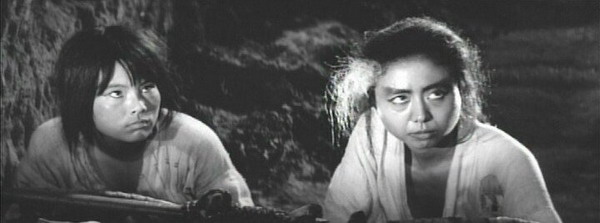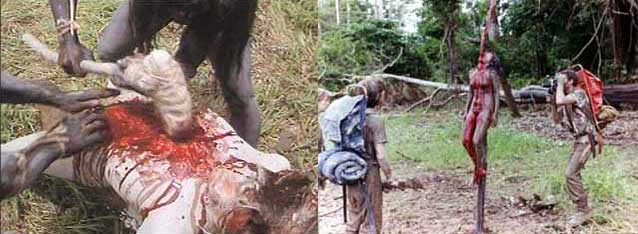

Culture
“I defer to the new cinematic revolution coming
to Japan, which manifests women’s victory and men’s defeat”
(Pio D’Emmilia, film reviewer)
Other possible descriptive schemes are more
likely to emphasize cultural factors directly. An interplay of sex
and death seems present in certain strands of Japanese popular culture
that encounters no general prohibition against depiction of the sadistic
exercise of absolute power. One version of the Okiku legend involves
an attempt by her Lord to coerce the maid into a sexual liaison, which
she escapes by drowning herself in the well. Although it might
seem obvious that the artistic treatment of sadomasochistic behavior would
be related to the relevant position of women in Japanese society, horror
– by its very definition – violates the boundaries of accepted norms.
Japanese horror films by no means exclusively situate the female body as
an object to be deconstructed in bizarre ways. Female characters
themselves exercise lethally sadistic control from the time of “Onibaba”
to “Banquet of the Beasts.” In these film contexts sex itself may
be used as a weapon by women – a means of sadistic control – in a manner
that directly challenges background assumptions of patriarchal power or
entitlement.
 If horror is defined by the “liminal” or boundary-violating,
then such films may provide a record of the boundary conditions in contemporary
Japanese culture that form the fault lines between power and submission,
conformity and individualism, life and death. As an example, the
“Shurayukihime” (“Lady Snowblood”) films of 1973 and 1974 are not generally
regarded as horror. However, their themes of serial killing and embrace
of the abject in the form of an “Eta” (“filth”) clan or of persons with
the plague could clearly be described as boundary violating. Embrace
of the abject – particularly in the context of the radical politics of
the 1970s – may itself constitute a subversive act.
If horror is defined by the “liminal” or boundary-violating,
then such films may provide a record of the boundary conditions in contemporary
Japanese culture that form the fault lines between power and submission,
conformity and individualism, life and death. As an example, the
“Shurayukihime” (“Lady Snowblood”) films of 1973 and 1974 are not generally
regarded as horror. However, their themes of serial killing and embrace
of the abject in the form of an “Eta” (“filth”) clan or of persons with
the plague could clearly be described as boundary violating. Embrace
of the abject – particularly in the context of the radical politics of
the 1970s – may itself constitute a subversive act.
 Potentially interesting cultural differences may
be found in the construction of “the abject.” Much of Western horror
film could be characterized as grounded on an unexpected return of the
primitive “other.” In such narratives, city dwellers are depicted
as feminine or feminized and are frequently accosted by marginalized individuals
who inhabit or emerge from remote locations. Sometimes the monster
or monstrous influence is an animal. Threats often lurk within the
natural, non-urban world – in the forest, caves or beneath the ground or
ocean. The lycanthrope may return to the forest, while the dead may
rise from the earth itself. This construction pits technological,
rule-governed humankind against that which is natural and rural.
Intolerance of animism is deeply rooted in Western culture, while animism
is central to Shinto. For Western culture the locus of the uncanny
may be at the periphery of urban life or in the scientifically inexplicable,
while Japanese culture embraces and reveres the natural world – at least
in principle – although to the highly urbanized characters of films such
as “Ghost System” or “Hallucination” a remote rural setting is redolent
with threat.
Potentially interesting cultural differences may
be found in the construction of “the abject.” Much of Western horror
film could be characterized as grounded on an unexpected return of the
primitive “other.” In such narratives, city dwellers are depicted
as feminine or feminized and are frequently accosted by marginalized individuals
who inhabit or emerge from remote locations. Sometimes the monster
or monstrous influence is an animal. Threats often lurk within the
natural, non-urban world – in the forest, caves or beneath the ground or
ocean. The lycanthrope may return to the forest, while the dead may
rise from the earth itself. This construction pits technological,
rule-governed humankind against that which is natural and rural.
Intolerance of animism is deeply rooted in Western culture, while animism
is central to Shinto. For Western culture the locus of the uncanny
may be at the periphery of urban life or in the scientifically inexplicable,
while Japanese culture embraces and reveres the natural world – at least
in principle – although to the highly urbanized characters of films such
as “Ghost System” or “Hallucination” a remote rural setting is redolent
with threat.
 Consequently, the source of the uncanny in much
of Japanese horror may differ from Western horror films. Perhaps
the greatest recent existential threat to Japanese culture has involved
“outsider” influences, of which unrestrained modernism and imported technological
practices are contemporary visible manifestations. It is perhaps
unsurprising, therefore, that Japanese horror might dwell on the socially
destabilizing influences of shocking American crime figures, informal social
behaviors, or even everyday technology. All have profoundly altered
Japanese cultural traditions in ways that have been popularly perceived
as threatening, and in postwar Japanese cinema violence itself sometimes
serves as a metaphor for anxiety over American cultural control.
Japanese horror films tend to situate the uncanny with the forces of technology
and social change. In the highly popular Miyazaki anime “Mononoke-hime”
(“Princess Mononoke”) the modernizing forces of “Irontown” (led by a woman)
seek to subdue and destroy the forest spirit and the source of life itself.
Technology and social progress – not the reclusive forest spirit – is the
existential threat. When “Godzilla” tramples and burns Tokyo with
his fiery breath this perhaps recalls the 1945 firebombing that constituted
the most concentrated act of mass destruction in human experience.
Consequently, the source of the uncanny in much
of Japanese horror may differ from Western horror films. Perhaps
the greatest recent existential threat to Japanese culture has involved
“outsider” influences, of which unrestrained modernism and imported technological
practices are contemporary visible manifestations. It is perhaps
unsurprising, therefore, that Japanese horror might dwell on the socially
destabilizing influences of shocking American crime figures, informal social
behaviors, or even everyday technology. All have profoundly altered
Japanese cultural traditions in ways that have been popularly perceived
as threatening, and in postwar Japanese cinema violence itself sometimes
serves as a metaphor for anxiety over American cultural control.
Japanese horror films tend to situate the uncanny with the forces of technology
and social change. In the highly popular Miyazaki anime “Mononoke-hime”
(“Princess Mononoke”) the modernizing forces of “Irontown” (led by a woman)
seek to subdue and destroy the forest spirit and the source of life itself.
Technology and social progress – not the reclusive forest spirit – is the
existential threat. When “Godzilla” tramples and burns Tokyo with
his fiery breath this perhaps recalls the 1945 firebombing that constituted
the most concentrated act of mass destruction in human experience.
 Beyond any consideration of the uncanny, there
is also the intriguing issue of possible cultural differences in viewer
response to horrific stimuli. During the 1960s and 1970s the British
horror film studio Hammer Films produced three versions of its titles,
the strongest and goriest being for the Japanese market. The notorious
1980 Italian quasi-snuff film “Cannibal Holocaust” was one of the top ten
highest grossing films of its time in Japan. Contemporary Japanese
horror films may have a reputation for bloodthirstiness, but it is fair
comment that many of their most egregious content such as medical experimentation,
dismemberment, eyeball piercing or the disturbing conflation of bodily
destruction and sensuality were all pioneered by European horror productions
between the 1960s and 1980s in titles that were also consumed in Japan.
Beyond any consideration of the uncanny, there
is also the intriguing issue of possible cultural differences in viewer
response to horrific stimuli. During the 1960s and 1970s the British
horror film studio Hammer Films produced three versions of its titles,
the strongest and goriest being for the Japanese market. The notorious
1980 Italian quasi-snuff film “Cannibal Holocaust” was one of the top ten
highest grossing films of its time in Japan. Contemporary Japanese
horror films may have a reputation for bloodthirstiness, but it is fair
comment that many of their most egregious content such as medical experimentation,
dismemberment, eyeball piercing or the disturbing conflation of bodily
destruction and sensuality were all pioneered by European horror productions
between the 1960s and 1980s in titles that were also consumed in Japan.
 These “Eurotrash” and, specifically, Italian “giallo”
titles were part of a broader cultural movement against conventional mores
and censorship restrictions that can trace its lineage to the Parisian
Grand Guignol Theater of the early 20th Century. Such popular culture
influences may have resonated with similar modernizing themes in Japan,
and both stage and cinematic adaptations of the Grand Guignol have been
cited by prolific J-Horror screenwriter Hiroshi Takahashi as explicit influences
on the script of his contemporary work “Crazy Lips.” However, expressions
of sensuality and bodily excess have never been as constrained in Japanese
popular culture and the arts, lending a differing context to notionally
“subversive” material. Fetish, ritual and nuance have played a more
prominent role in Japanese cultural expression – both high and low – suggesting
that the depictions of the body in extremis may resonate differently in
this entertainment culture. Takashi Ishii’s extended examination
of nawa shibari in “Hana to hebi” (“Flower and Snake,” 2004), for example,
has no possible equivalent expression in Kubrick’s “Eyes Wide Shut,” despite
obvious plot similarities.
These “Eurotrash” and, specifically, Italian “giallo”
titles were part of a broader cultural movement against conventional mores
and censorship restrictions that can trace its lineage to the Parisian
Grand Guignol Theater of the early 20th Century. Such popular culture
influences may have resonated with similar modernizing themes in Japan,
and both stage and cinematic adaptations of the Grand Guignol have been
cited by prolific J-Horror screenwriter Hiroshi Takahashi as explicit influences
on the script of his contemporary work “Crazy Lips.” However, expressions
of sensuality and bodily excess have never been as constrained in Japanese
popular culture and the arts, lending a differing context to notionally
“subversive” material. Fetish, ritual and nuance have played a more
prominent role in Japanese cultural expression – both high and low – suggesting
that the depictions of the body in extremis may resonate differently in
this entertainment culture. Takashi Ishii’s extended examination
of nawa shibari in “Hana to hebi” (“Flower and Snake,” 2004), for example,
has no possible equivalent expression in Kubrick’s “Eyes Wide Shut,” despite
obvious plot similarities.









